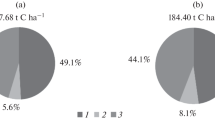Summary
Condition in the understory of aBetula-carr appeared to be favourable for the growth ofSphagnum recurvum. The estimates of annual productivity and nutrient accumulations forS. recurvum obtained in this wetland forest are in the high range of those reported for peatmosses. On an annual basis, the organic matter production, vegetative reproduction (forking), and accumulation of N, P and K were very much the same for a relatively dry and for a relatively wet year. Periodicity in growth and length increase of the plants, however, differed remarkably between these years, and fruiting was observed in the dry year only.S. recurvum was characterized by a distinct variation in nutrient concentrations both with time and with distance from the capitulum. Organic weight loss during breakdown ofS. recurvum in the wetland forest was low. Release of N, P and particularly K was larger than that of organic matter in decomposingS. recurvum. Nevertheless, a relatively large proportion of the original N and P stock remained associated with the peatmoss material after a 12 month decay period. Observations with the scanning electron microscope revealed that after a year the cells of deadS. recurvum were hardly damaged and only poorly colonized by microorganisms. The characteristics ofS. recurvum described here indicate its potency in directing succession in peatland forests.
Similar content being viewed by others
References
Andrus RE (1986) Some aspects ofSphagnum ecology. Can J Bot 64:416–426
Brock TCM, Bongaerts MCM, Heijnen GJMA, Heijthuijsen JHFG (1983) Nitrogen and phosphorus accumulation and cycling byNymphoides peltata (Gmel.) O. Kuntze (Menyanthaceae). Aquat Bot 17:189–214
Brock TCM, De la Haye MAA, Tenner W (1988) History, population structure and phytomass production ofBetula pubescens in a wetland forest. In: Verhoeven JTA, Heil GW, Werger MJA (eds) Vegetation structure in relation to carbon and nutrient economy. SPB Academic Publishing. The Hague, pp 45–50
Brock TCM, Van der Hammen T, Van der Molen PC, Ran ETH, Van Reenen GBA, Wijmstra TA (1989) An account of the history, flora and vegetation of nature reserve ‘Het Molenven’, Province of Overijssel, The Netherlands. Proc K Ned Akad Wetensch Ser B 92:1–46
Clymo RS (1970) The growth ofSphagnum: methods of measurements. J Ecol 58:13–49
Clymo RS (1973) The growth ofSphagnum: some effects of environment. J Ecol 61:849–869
Clymo RS, Hayward PM (1982) The ecology ofSphagnum. In: Smith AJE (ed) Bryophyte ecology, Chapman and Hall, London and New York, pp 229–289
Coulson JC, Butterfield J (1978) An investigation of the biotic factors determining the rates of plant decomposition on blanket bog. J Ecol 66:631–650
Damman AWH (1978) Distribution and movement of elements in ombrotrophic peat bogs. Oikos 30:480–495
Dykyjová D (1979) Selective uptake of mineral ions and their concentration factors in aquatic higher plants. Folia Geobot Phytotaxon 14:267–325
Goodman GT, Perkins DF (1968) The role of mineral nutrients inEriophorum communities. IV. Potassium supply as a limiting factor in anE. vaginatum community. J Ecol 56:685–696
Green BH (1968) The factors influencing the spatial and temporal distribution ofSphagnum imbricatum Hornsch. ex Russ. in the British Isles. J Ecol 56:47–58
Hayward PM, Clymo RS (1983) The growth ofSpagnum: experiments on, and simulation of, some effects of light flux and water-table depth. J Ecol 71:845–863
Hill MO (1978) Sphagnopsida. In: Smith AJE (ed) The moss flora of Britain and Ireland, Cambridge University Press, London, pp 30–78
Lindner RC, Harley CP (1942) A rapid method for the detemination of nitrogen in plant tissue. Science 96:565–566
Malmer N (1962) Studies on mire vegetation in the Archaean area of southwestern Götaland (South Sweden). II. Distribution and seasonal variation in elementary constituents on some mire sites. Opera Bot 7:1–67
Malmer N, Sjörs H (1955) Some determinations of elementary constituents in mire plants and peat. Bot Not 108:46–80
Overbeck F (1975) Botanisch-geologische Moorkunde. Wachholtz, Neumünster, p 719
Overbeck F, Happach H (1956) Über das Wachstum und den Wasserhaushalt einiger Hochmoorsphagnen. Flora (Jena) 144:335–402
Pakarinen P (1978) Production and nutrient ecology of threeSphagnum species in southern Finnish raised bogs. Ann Bot Fennica 15:15–26
Pedersen A (1975) Growth measurements of fiveSphagnum species in South Norway. Norw J Bot 22:277–284
Schuurkes JAAR (1987) Acidification of surface waters by atmospheric deposition. Thesis Catholic University Nijmegen, p 160
Tamm CO (1954) Some observations on the nutrient turn-over in a bog community dominated byEriophorum vaginatum L. Oikos 5:189–194
Titus JE, Wagner DJ, Stephens MD (1983) Contrasting water relations of photosynthesis for twosphagnum mosses. Ecology 64:1109–1115
Van Geel B, Hallewas DP Pals JP (1983) A late holocene deposit under the westfriese zeedijk near Enkhuizen (Prov. of Noord-Holland, The Netherlands): palaeoecological and archeological aspects. Rev Palaeobot Palynol 38:269–335
Verhoeven JTA (1986) Nutrient dynamics in minerotrophic peat mires. Aquat Bot 25:117–137
Verhoeven JTA, Van Beek S, Dekker M, Storm W (1983) Nutrient dynamics in small mesotrophic fens surrounded by cultivated land. I. Productivity and nutrient uptake by the vegetation in relation to the flow of eutrophicated ground water. Oecologia 60:25–33
Wagner DJ, Titus JE (1984) Comparative desiccation tolerance of twoSphagnum mosses. Oecologia 62:182–187
Wiegers J (1985) Succession in fen woodland ecosystems in the Dutch haf district. Dissertationes Botanicae 86, J Cramer, Vaduz, p 152
Author information
Authors and Affiliations
Rights and permissions
About this article
Cite this article
Brock, T.C.M., Bregman, R. Periodicity in growth, productivity, nutrient content and decomposition ofSphagnum recurvum var.mucronatum in a fen woodland. Oecologia 80, 44–52 (1989). https://doi.org/10.1007/BF00789930
Received:
Published:
Issue Date:
DOI: https://doi.org/10.1007/BF00789930




